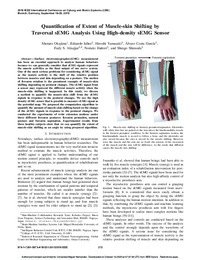Please use this identifier to cite or link to this item:
https://hdl.handle.net/11000/6501Full metadata record
| DC Field | Value | Language |
|---|---|---|
| dc.contributor.author | Iáñez Martínez, Eduardo | - |
| dc.contributor.author | Costa García, Álvaro | - |
| dc.contributor.author | Sonoo, Moeka | - |
| dc.contributor.author | Okajima, Shotaro | - |
| dc.contributor.author | Yamasaki, Hiroshi | - |
| dc.contributor.author | Sayako Ueda, Sayako | - |
| dc.contributor.author | Shimoda, Shingo | - |
| dc.contributor.other | Departamentos de la UMH::Ingeniería de Sistemas y Automática | es |
| dc.date.accessioned | 2020-10-15T07:00:13Z | - |
| dc.date.available | 2020-10-15T07:00:13Z | - |
| dc.date.created | 2020-02-21 | - |
| dc.date.issued | 2020-10-15 | - |
| dc.identifier.uri | http://hdl.handle.net/11000/6501 | - |
| dc.description.abstract | Averaging electromyographic activity prior to muscle synergy computation is a common method employed to compensate for the inter-repetition variability usually associated with this kind of physiological recording. Capturing muscle synergies requires the preservation of accurate temporal and spatial information for muscle activity. The natural variation in electromyography data across consecutive repetitions of the same task raises several related challenges that make averaging a non-trivial process. Duration and triggering times of muscle activity generally vary across different repetitions of the same task. Therefore, it is necessary to define a robust methodology to segment and average muscle activity that deals with these issues. Emerging from this need, the present work proposes a standard protocol for segmenting and averaging muscle activations from periodic motions in a way that accurately preserves the temporal and spatial information contained in the original data and enables the isolation of a single averaged motion period. This protocol has been validated with muscle activity data recorded from 15 participants performing elbow flexion/extension motions, a series of actions driven by well-established muscle synergies. Using the averaged data, muscle synergies were computed, permitting their behavior to be compared with previous results related to the evaluated task. The comparison between the method proposed and a widely used methodology based on motion flags, shown the benefits of our system maintaining the consistency of muscle activation timings and synergies | es |
| dc.format | application/pdf | es |
| dc.format.extent | 7 | es |
| dc.language.iso | eng | es |
| dc.rights | info:eu-repo/semantics/openAccess | es |
| dc.subject | Motion control | es |
| dc.subject | human-centered robotics, | es |
| dc.subject | biologically-inspired robots | es |
| dc.subject | rehabilitation robotics | es |
| dc.subject.other | 62 - Ingeniería. Tecnología | es |
| dc.title | Quantification of Extent of Muscle-skin Shifting by Traversal sEMG Analysis Using High-density sEMG Sensor | es |
| dc.type | info:eu-repo/semantics/article | es |
| dc.identifier.doi | 10.1109/LRA.2020.2975729 | - |
| dc.relation.publisherversion | http://dx.doi.org/10.1109/LRA.2020.2975729 | - |

View/Open:
5-Quantification of Extent of Muscle-skin.pdf
4,55 MB
Adobe PDF
Share:
.png)
